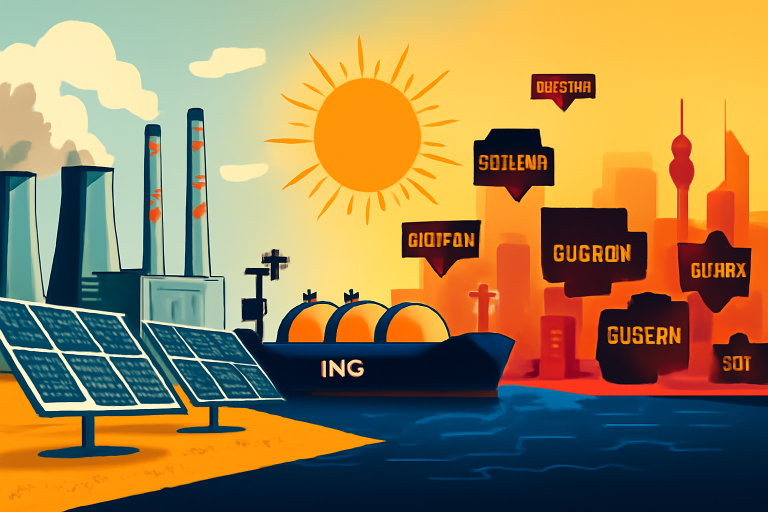Kuwait faces a growing energy crisis due to extreme heat, aging infrastructure, and frequent power outages, despite ambitious plans to boost renewable energy to 15% by 2030 from its current less than 1%.
A Rystad Energy analysis suggests this ambitious goal may be unattainable.
“Our current projections estimate renewable capacity will only reach 3.3 gigawatts (GW) by 2030, just 7% of Kuwait’s power generation, with a renewables share of 15% by 2035, a more realistic target,” the Norway-based intelligence energy firm said in a release.
By that time, renewable capacity is expected to exceed 11 GW, accounting for around 20% of Kuwait’s power generation.
Existing capacity
At present, Kuwait possesses an installed capacity of 21 GW; however, only approximately 17 GW of this is dependably accessible during peak months.
This is primarily due to scheduled maintenance and the aging infrastructure of its power plants.
In recent years, temperatures have soared to 50 degrees Celsius, leading to a peak demand of 17.7 GW in July.
This surge resulted in scheduled power cuts commencing two months earlier than the previous year. Additionally, unplanned outages exacerbated the situation, causing shortages exceeding 1.5 GW during May’s peak demand.
“Blackouts in Kuwait have underscored the strain on the country’s power system, making imports unavoidable if such outages persist. As Kuwait modernizes and turns to renewables to address these challenges, high-profile events like the 2025 Iberian outage have raised questions about the reliability of renewable energy,” Nishant Kumar, analyst, Renewables & Power Research, Rystad Energy, said.
Still, it would be myopic to dismiss the capabilities of renewables outright.
With over 3,300 hours of sunlight annually, Kuwait is poised to make significant investments in solar PV.
This natural advantage allows for substantial PV output, ranging from 4.6 to 4.9 kWh per kilowatt-peak daily, which is crucial for addressing peak electricity demand in the afternoon, according to Kumar.
Gas and imports
As Kuwait transitions its energy landscape and expands renewable energy use, gas is poised to be a crucial component of its future energy mix.
Rystad Energy’s analysis forecasts a 17% increase in Kuwaiti gas power generation, reaching 77 terawatt-hours (TWh) by 2030.
This growth is expected to drive a 38% rise in gas production, with overall gas demand projected to increase by 30% within the next five years.
Demand growth will be met through a combination of increased domestic gas production and continued liquefied natural gas (LNG) imports, guaranteeing a continuous supply.
For example, Kuwait plans to build five large-scale gas-fired power plants, adding 18 GW of capacity and increasing its total gas power capacity from 14 GW today to over 32 GW by 2035.
To support imports, the state-owned Kuwait Petroleum Corporation (KPC) has signed a 15-year LNG sale and purchase agreement with QatarEnergy, securing up to 3 million tonnes per annum of supply.
Oil export and gas transition
Kuwait aims to reduce domestic oil consumption by transitioning its power generation from oil to gas.
This strategic shift will free up more crude oil for export, which is crucial given that oil sales are the primary driver of Kuwait’s economy and government revenue, according to Rystad.
The nation intends to maximise export earnings, bolster its fiscal stability, and ensure long-term revenue streams as domestic power demand continues to rise. The power sector currently accounts for 40% of Kuwait’s energy needs.
Kuwait’s annual gas demand, primarily driven by the power sector, ranges from 24 to 25 billion cubic meters (bcm).
Currently, 40% of this demand is fulfilled by LNG imports, and 35% comes from associated gas production, Rystad Energy said. However, reliance on associated gas makes Kuwait vulnerable to OPEC+ crude output cuts, which directly impact gas availability.
To counter this risk, Kuwait has significantly invested in developing non-associated gas resources through onshore projects and offshore exploration.
This strategy has shown considerable success, with non-associated gas now supplying approximately 25% of the total demand, or nearly 600 million cubic feet per day, the agency said.
All current volumes of non-associated gas are sourced from the onshore Jurassic project in northern Kuwait.
The post Kuwait’s ambitious renewable energy goals face reality check appeared first on Invezz

